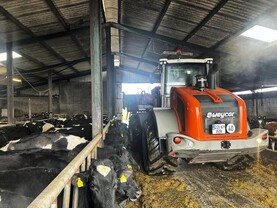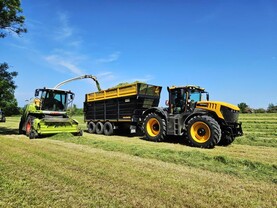The new JCB Fastrac looks and feels modern, with an aggressive tone to the styling, a curved bonnet and integrated lights in the front grill, plus a completely new cab.
The new 4000 series models will be powered by a 6.6-litre six-cylinder AGCO power engine that meets latest Euro Stage 4 / US Tier 4 Final exhaust emissions rules using SCR technology (AdBlue). Table 1 summarises the rated and maximum horsepower (hp) for each model in the range.
Sales and marketing manager with JCB Edward Roach said: “This tractor has been developed to what the customer wants in a JCB Fastrac.”
JCB benchmarked the tractor against leading competitors and listened to what the problems were with previous versions. This model addresses those needs to deliver a tractor with more functionality across more tasks. JCB’s ambition for this tractor is that it’s not just a road-runner, but is equally at home operating a seed drill or sprayer in the field.
New chassis
According to JCB, this is the major leap in transforming the tractor into an all-round machine on the farm. The chassis is completely new, and integrates the new driveline, transmission and suspension on the series.
JCB’s unique self-levelling rear-axle suspension is matched by front-axle self-levelling suspension replacing the old coil spring system. JCB claims the advantage of this is that it maintains the correct ride height, wherever the implement is mounted.
This worked well in the field test, as the suspension gave good draught to the plough at six-sod reversible. The plough lifted out of work with no problem to the tractor’s stability. The tractor had front linkage and a weight block fitted.
The optional double-acting suspension allows the tractor to squat and slide in under a demount sprayer, spreader or bulk hopper for quicker and easier switching between different tasks.
The Fendt vario transmission replaces the old semi-powershift gearbox that was on offer in the 2000 series. The CVT transmission really works well, giving a top speed of 60km/h. There are essentially three settings. The drive mode, which is fully automatic; powershift mode, which enables the driver to operate the JCB like a standard tractor; and manual mode. The selection is easily done on the display monitor, which also displays the selected mode. The transmission on this tractor will suit virtually all tasks on the farm and road.
A big criticism of previous models of the Fastrac was compatibility with other tractors in the fleet. The PTO shaft needed to be longer or extra length was required on hydraulic hoses, making it impossible to share implements. JCB said this will not be an issue now, as the new chassis design has allowed improved access points and clearance.
In the field
The first impression as a non-Fastrac driver was how smooth this tractor actually runs at speed in the field. I travelled at speeds that I would never have considered in a standard tractor.
Those operators familiar with the Fastrac family of tractors will already have appreciated that on the road.
Access to the cab is good, with clear visibility in all directions around the cab. The bonnet is wide at the nose and tapers in towards the cab, giving good visibility of the wheels and allowing for an improved turning angle.
Fitted with 540/65 R30 tyres all round, the Fastrac now boasts a 9.8m turning circle, reduced by 1.7m on the 2000 series. The view out over the bonnet is slightly restricted for loader work, but not to a large extent or to any great difference to other tractors with similar power.
The other task carried out was a mock-up drilling operation with a 6m Amazone one-pass with a front and rear hopper on the 4220 model. This gave us the opportunity to examine the headland turn assist functions.
The display terminal allows input of each sequence for the selected operation – raising the machine, turning off the PTO and lowering the machine after a correct distance is travelled out from the headland.
The system works, but I did find it a bit tricky to navigate. The screen could have been clearer, with more command prompts. Perhaps more driving time on the machine would give a better understanding of the software.
However, it is a working programme that carries out all the functions required.
This tractor is incredibly smooth in the field. The design did not hinder any field operation, and probably improved the comfort of some of the tasks.
Getting the steering right
There are five steering modes – two-wheel steer; proportional four-wheel steer, where the front wheels turn 2° for every 1° at the back; true-tracking, where the rear wheels follow the front; delayed four-wheel steering; and crab steering.
These settings are selected by a similar switch found on a JCB loadall. For safety, at higher speeds four-wheel steering is disengaged over 25km/h. Software allows for the four-wheel mode to be automatically switched back on when the tractor drops to below 25km/h.
In addition, when the optional fast steer is specified, the operator can select one of two steering ratios standard for road use and general field work.
The high steering ratio allows for just two turns of the steering wheel to lock the wheels in the chosen direction. This has advantages when working in a confined area, at the headland or with a front loader.
The fast steer can also be integrated into the headland management for quick turning when ploughing or sowing.
Hydraulics and PTO
The flow-on-demand closed centre or power-beyond package gives 148-litres per minute when required. At the spool valve, the flow rate is 100 litres per minute. The tractor can come with up to five spool valves that are electrically controlled.
The flow rate and headland functions can be changed easily on the monitor. The three-point linkage is also improved. It has 30% greater rear lift capacity than before at 8,000kg, and 20% more at the front, at 3,000kg. The Fastrac is available with 540, 540E, 1,000 and 1,000E PTO speeds. The front PTO is only available with 1,000-speed PTO drive.
The new cab
This tractor no longer borrows a cab of the backhoe digger. It gets a new design specifically for this model, and it works. It would remind you of a combine cab where the forward-racked windscreen gives more room for the upper body. As mentioned earlier, access is good, and the lights stay on when leaving the tractor to avoid nasty falls in the dark.
The spacious feel of the cab and comfort level are big plus points. The dash is illuminated, allowing clear interpretation of the dials. One downside for me was that the roof hatch is not standard but an optional extra. Also, the position of the display terminal is slightly behind you in the driving seat. The rest of the cab has well-built, solid switches on the cab post. The cab is a six-post design, which allows for two neat, opening side windows to the rear of the cab, a nice breath of air if the air con dies. I did find it hard to find a place for my phone and bits. But, overall, this cab is very comfortable for a long day’s work.
Verdict
The JCB Fastrac 4000 series tractors are now a serious option for all jobs on the farm, not just haulage.
Anyone who has not considered it before for this reason should relook at it now.
In the UK, the Fastrac has a loyal following among existing customers.
The question is, has enough been done to make the new 4000 series appeal to all farmers?
We like:
v Big, comfortable cab.
v Smooth CVT transmission.
v Ultra-smooth performance in the fields.
v Accessible controls on the tractor mudguard.
v New styling.
We dislike:
X Difficult to follow headland management system.
X A lot of software needed for this tractor to function.
X Lack of place holders in the cab.






 This is a subscriber-only article
This is a subscriber-only article















SHARING OPTIONS: